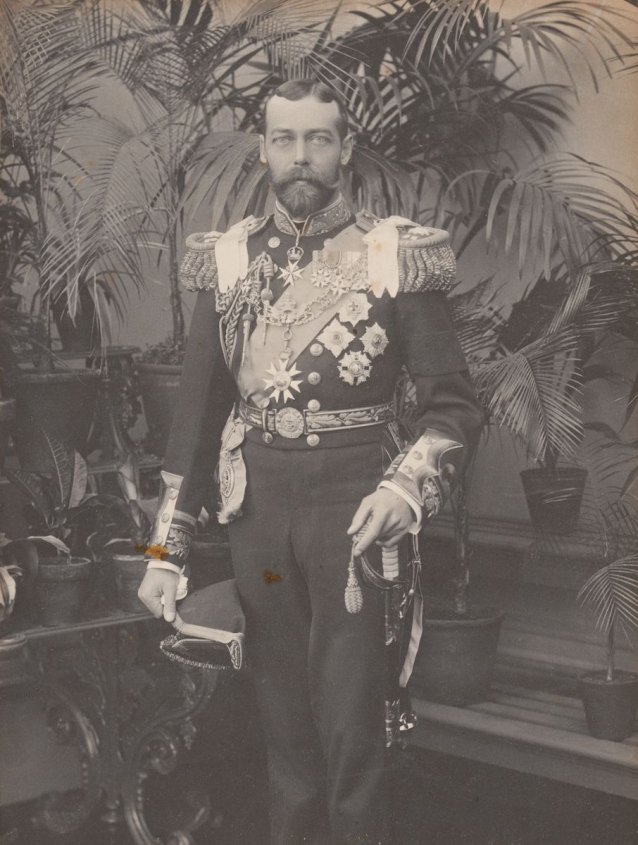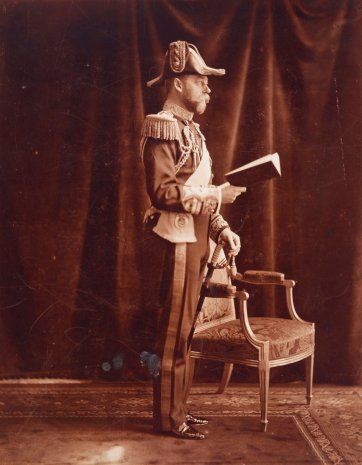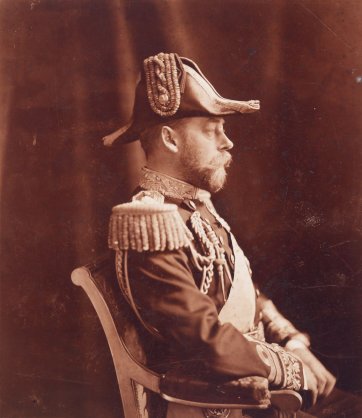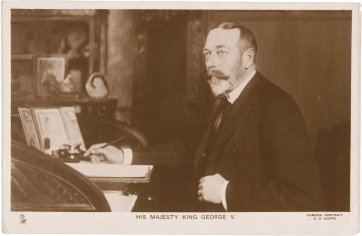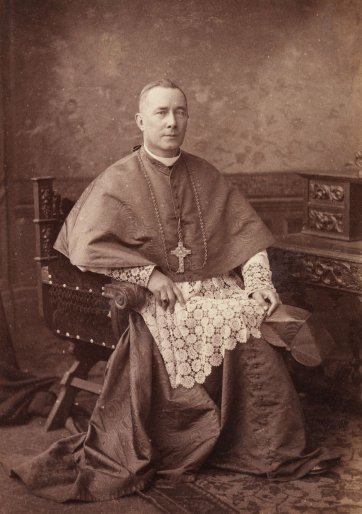George Frederick Ernest Albert, The Duke of Cornwall and York and later King George V (1865-1936), was the son of Edward VII, the man for whom the Edwardian era was named. A grandson of Queen Victoria’s, George grew up third in line to the throne, behind his father and his older brother, Albert Victor. From the age of 12 he served alongside his brother in the British Navy; together, they travelled the world on HMS Bacchante from 1879 to 1881. George continued active service, commanding a torpedo ship, HMS Thrush and HMS Melampus until 1892. That year, Albert Victor, recently engaged to marry Mary of Teck, died. Having mourned him in tandem, George and Mary (1867-1953) married in mid-1893.
Upon the death of Queen Victoria, the 59-year-old Edward VII took the throne. The first Parliament of the Commonwealth of Australia was set to open not much more than three months after the coronation. The mourning King sent his heir, now known as the Duke of Cornwall and York, to Australia as his representative. The Duke and Duchess left England on 15 March, and on 9 May the Duke declared the Parliament open in a grand ceremony in the Exhibition Building, Melbourne, attended by thousands of guests. The Daily Telegraph reported that ‘All the surrounds were magnificent – the crowded streets outside the great Exhibition, with thousands of faces stretching away to the right and left, and in front of the dazzling uniforms of the visitors, the array of brilliant costumes and gorgeous dresses, forming a fitting setting for a celebration so grand, so unique, so essentially patriotic… The fact that the Duke of Cornwall and York was to perform the ceremony added enormously to the public interest in the function.’ The Bulletin’s correspondent, by contrast, wrote that the proud occasion could do without the participation of a ‘thin undersized man who has never done anything save be born, and grow up, and get married and exist by breathing regularly and be the son of his father who did the same things. And in the public eye he was, apparently, about three quarters of the pageant. The men who made the Commonwealth were eclipsed… by the man who has made nothing of any importance.’
George and Mary proceeded through the Empire for 8 months. In late 1901 they became Prince and Princess of Wales, in which capacity they also travelled widely. Soon after their coronation in June 1911, they went to India, where the Prince declared Delhi the new capital and shot 21 tigers and 8 rhinoceroses. First cousin of Kaiser Wilhelm II, during the First World War he changed the name of the British Royal family from Saxe-Coburg-Gotha to Windsor, and many of his relatives dropped German family names or were stripped of German titles. In 1918 Bolsheviks killed another of his first cousins, Tsar Nicholas. After the war, until he died in 1936, he was reluctant to leave England. In 1922, Ireland was partitioned. In 1924, he appointed the first Labour prime minister. During the Depression, he sought to lessen the distance between the palace and the people, appearing to sympathise, as best as he was able, with the working class. In 1932 he delivered the first Royal address on the wireless. By the time he publicly deplored the rise of Nazi Germany, he was immensely popular. George and Mary had six children, of whom two became King: first Edward (who became King Edward VIII and, after abdication, the Duke of Windsor) and Albert Frederick Arthur George (who became King George VI). His great favourite, his granddaughter ‘Lilibet’, has been HM Queen Elizabeth II for the last 61 years. The 85-year-old Queen Mary is the central figure in the famous photograph of the three black-clad queens at the funeral of George VI in 1952.
Collection: National Portrait Gallery
Gift of Peter Roberts 2015
The National Portrait Gallery respects the artistic and intellectual property rights of others. Works of art from the collection are reproduced as per the
Australian Copyright Act 1968 (Cth). The use of images of works from the collection may be restricted under the Act. Requests for a reproduction of a work of art can be made through a
Reproduction request. For further information please contact
NPG Copyright.
